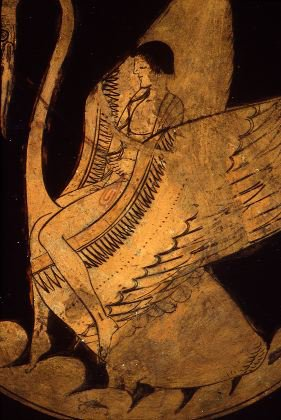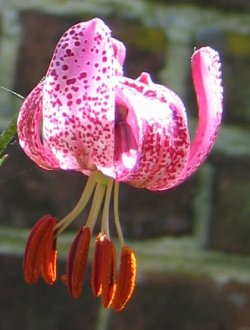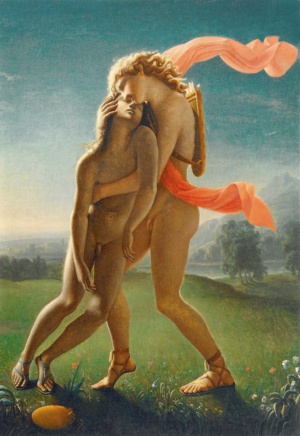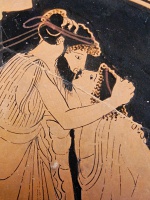Hyacinth (mythology)

Hyacinth or Hyacinthus (/ˈhaɪəsɪnθ/; Ancient Greek: Ὑάκινθος Huákinthos), a divine hero in Greek mythology, was a beautiful youth loved by Apollo.
Hyacinth was given various parentage, providing local links, as a son that Clio, the muse of history, had either with King Pierus of Macedon, with King Oebalus of Sparta, or with King Amyclas of Sparta,[1] the progenitor of the people of Amyclae (Greek: Αμύκλες), a city of ancient Laconia. According to a local Spartan version of the story, Hyacinth and his sister Polyboea were taken to Elysium by Aphrodite, Athena and Artemis.[2]
His cult was located at the city of Amyclae, the ruins of which, situated 2 km northeast of the modern village of Amykles, date from the Mycenaean era (1600–1100 BC).[3] The sanctuary (temenos) grew up around his burial mound (tumulus), located during the Classical period at the feet of a statue of Apollo.[4]
Mythology

In the literary myth, Hyacinth was a young Spartan prince, beloved of the god Apollo (who acted in the role of his teacher/mentor) and admired by Zephyrus, the West Wind.

One day, as Apollo and Hyacinth took turns throwing the discus, Hyacinth ran to catch it to impress Apollo, and was struck by the discus as it fell to the ground.[5] Apollo, holding the dying youth, desperately tried to use his skill with medicine to keep him alive. But even the mighty god of healing could not save his beloved, and Hyacinth died in his arms.
A twist in the tale makes the wind god Zephyrus responsible for the death of Hyacinth.[6] His beauty had caused a feud between Zephyrus and Apollo. Jealous that Hyacinth preferred the radiant archery god Apollo, Zephyrus blew Apollo's discus off course, so as to injure and kill Hyacinth. When he died, the grief-stricken Apollo did not allow Hades to claim the youth; rather, he made a flower, the hyacinth, from his spilled blood. According to Ovid's account, the tears of Apollo stained the newly formed flower's petals with the sign of his grief. The flower of the mythological Hyacinth has been identified with a number of plants other than the modern hyacinth, such as the iris, the larkspur and the martagon lily, as well as other flowers indigenous to the region.[7]
Hyacinth was the tutelary deity (a deity or spirit who is a guardian, patron or protector) of one of the principal Spartan festivals, the Hyacinthia, held every summer. The festival lasted three days, one day of mourning for the death of the divine hero Hyacinth, and the last two celebrating his rebirth as Apollo Hayakinthios, though the division of honours is a subject for scholarly controversy.[8] The festival was important enough to the Spartans that they were said to have broken off military campaigns and negotiated truces in order to return home and celebrate it.[9][10]
Cultural significance

Apollo teaches Hyacinth to become an accomplished adult. Indeed, according to Philostratus, Hyacinth learns not only to throw the discus, but all the other exercises of the palaestra as well, to shoot with a bow, music, the art of divination, and also to play the lyre. Pausanias also mentions his apotheosis, represented on the pedestal of the ritual statue of the youth at Amyclae, his place of worship. The poet Nonnus of Panopolis mentions the resurrection of the youth by Apollo. Bernard Sergent finds that the death and resurrection, as well as the apotheosis, represent the transition to adult life.
The myth of Hyacinth, like that of Cyparissus, illuminates the social custom of pederasty in ancient Greece, with the boy, the beloved eromenos of Apollo, metamorphosing from youth to a different state of existence (adulthood). Pederastic myths often depict the process of initiation and transformation of the boy into adult male life,[11] with the allegorical "death" and transfiguration of the eromenos.
The name of Hyacinth is of pre-Hellenic origin, as indicated by the suffix -nth.[12] According to classical interpretations, his myth, where Apollo is a Dorian god, is a classical metaphor of the death and rebirth of nature, much as in the myth of Adonis. It has likewise been suggested that Hyacinth was a pre-Hellenic divinity supplanted by Apollo through the "accident" of his death, to whom he remains associated in the epithet of Apollon Hyakinthios.[13]
The Hyacinthia
The death and transformation (rebirth) of Hyacinth was celebrated at Amyclae by the second most important of Spartan festivals, the Hyacinthia (Ancient Greek: Ὑακίνθια Hyakínthia) in the Spartan month Hyacinthius in early summer (May/June). The festival lasted for three days:
- The first day was given over to mourning for the death of the hero: sacrifices were offered to the dead, banquets were stark and without pomp or decoration, the sacrificial breads were very plain.
- The second day was one of celebration for his rebirth. The young men and boys played the cithara and the aulos, and sang of the glory of Apollo. Others participated in horse races. Numerous choirs competed in town, singing country songs and dancing. Amyclae was also the location of parades of carts decorated by the girls and women of Sparta. Numerous sacrifices were offered, exclusively goats, with the occasion of the kopis (κοπίς), banquets where the citizens invited their friends and relatives. The helots had the right to participate in the celebrations, as did any foreigners: "they treat not only their countrymen, but any foreigners who happen by" (Athenaeus, IV, 138F). The kopis took place under special tents known as skēnaí (σκηναί), a characteristic trait of ancient country festivals.
- The third day is not described in detail, it is possible that it was more solemn, or that mysteries were held. It is also known that for this holiday, the Spartan women wove a chitōn (χιτών, "tunic") which is then offered to the god.
See also
Modern sources
- Gantz, Timothy (1993). Early Greek Myth. Baltimore: Johns Hopkins University Press.
- Kerenyi, Karl (1959). The Heroes of the Greeks. New York/London: Thames and Hudson.
References
- ↑ Pseudo-Apollodorus 3. 10.3; Pausanias 3. 1.3, 19.4.
- ↑ Pausanias 3. 19. 4.
- ↑ Modern day Amyclae is a village in Laconia, southern Greece. It lies in the plain by the Eurotas river, 6 km south of Sparta, east of the Taygetus mountains, along the Greek National Road 39 from Sparta to Gytheio and was named after the ancient town Amyclae.
- ↑ http://en.wikipedia.org/wiki/Hyacinth_%28mythology%29
- ↑ Pseudo-Apollodorus, 1. 3.3.
- ↑ Lucian, Dialogues of the Gods; Servius, commentary on Virgil Eclogue 3. 63; Philostratus, Imagines 1. 24; Ovid Metamorphoses 10. 184.
- ↑ Other divinely beloved vegetation gods who died in the flower of their youth and were vegetatively transformed, are Narkissos, Kyparissos and Adonis.
- ↑ As Colin Edmonson points out, Edmonson, "A Graffito from Amykla", Hesperia 28.2 (April - June 1959:162-164) p. 164, giving bibliography note 9.
- ↑ [1]
- ↑ Xenophon, in the Hellenics IV, 5, 11.
- ↑ http://en.wikipedia.org/wiki/Cyparissus
- ↑ "As the non-Greek suffix -nth indicates, Hyakinthos was an indigenous deity at Amyklae in Laconia", remarks Nobuo Komita, "Notes on the Pre-Greek Amyklaean God Hyakinthos", 1989 (http://www.kait-r.com/dspace/bitstream/10368/161/1/kka-013-005.pdf).
- ↑ Pierre Chantraine, Dictionnaire étymologique de la langue grecque, Klincksieck, 1999, article "ὑάκινθος", p. 1149 b.
